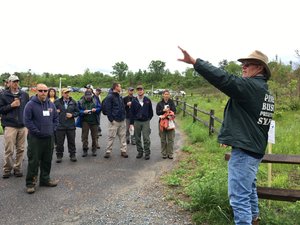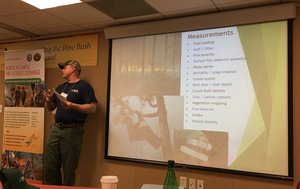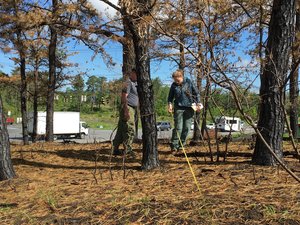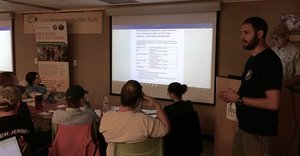Albany Pine Bush: Fire and Fuels Monitoring Workshop
- Inga La Puma
- Jul 25, 2017
- 4 min read
Updated: Dec 14, 2020
Photos by Inga La Puma
I was super excited to attend the Fire and Fuels Monitoring workshop and the opportunity to visit a unique outlying pitch pine/scrub oak ecosystem in Albany, New York for the first time. About 40 other folks were heading up to the Albany Pine Bush Preserve Discovery Center to make some serious headway on figuring out how to monitor fuels and fire effects. Little did we know we would be coming out of this meeting with a draft monitoring handbook for our region! I was in the New Jersey group along with several of my state colleagues and looking around I saw so many familiar faces from NAFSE activities we have hosted over the last two and a half years. What a great gathering of interested and passionate fire folks! Each table was a conglomeration of agencies and stakeholders, mainly from one state or region. In this way, all perspectives could be incorporated into designing a monitoring protocol for wildland fire and prescribed burns.
First we heard from Neil Gifford on the efforts underway at Albany Pine Bush in relation to fire and the restoration of the Karner Blue butterfly populations and habitat. The Albany Pine Bush Commission has come such a long way in the face of extraordinary challenges set amongst this suburban interface. Next we heard from Brian Sterns with an overview of what metrics are available to measure for fire effects with a wrap-up from Nick Skowronski. The theme was that “no one method fits everyone” and tailoring our monitoring protocol to our management needs was the way to go. It was a little rainy, but we were still able to head out on the trail to familiarize ourselves with the local system. We would be expected to practice our monitoring techniques on this system, so it was good to get a feel for it. This was all before noon!
Then, we went out to an area we used as a proxy for pre-burned conditions. Each group was assigned to try different monitoring practices in order to familiarize ourselves with the effort and technique for each. For example, our group did soil duff measurements along regular increments from plot center to 20ft out. We also measured scrub and tree height and recorded all of the species present in our plot. As we worked we realized how easily the sampling methods could get overbearing and un-workable for managers. The question then became, how could we get the information we needed for our region’s specific needs with the most streamlined sampling techniques available?

The next morning, Mike Gallagher presented his Ph.D. work on evaluating burn severity using remote sensing and also introduced us to composite burn index (CBI) plots. The methodology of calibrating remotely sensed images to plot level data and extrapolating the information across the landscape seemed very appealing to many groups, and several incorporated it into their practice monitoring. We put the CBI protocol into practice with some minor adjustments next. We headed outside the building to plots that had been recently thinned and burned (still black!). What a difference! Measurements of plots went much faster but it was more difficult to identify species and live versus dead shrubs. We tried one more site in a thinned and burned stand where re-sprouts were plentiful. Utilizing our techniques on several different types of plots gave us perspective on what type of plots we wanted to sample and how we wanted to organize our long-term sampling efforts. For New Jersey, we thought about what kind of team it might take to sample some areas more intensively, especially those areas that demonstrate management goals such as fuel reduction and forest health.
We entered data, we evaluated pre- and post-burn results, and one person from each team presented our results to the other participants. It was similar to what a manager might need to do on their home turf to demonstrate the outcome of different prescribed fire and fuel treatments. Finally, we put together a draft monitoring protocol handbook with much help from an example handbook provided by Jack McGowan-Stinski of the Lake States Fire Science Consortium. Each group described what to do and how to do it to accomplish the management goals of their region and presented their work to the rest of the room. Workshop participants came away with a draft protocol for sampling and monitoring fire and fuel effects. Whether the protocol is used or not, we now have a quorum of fire managers in the North Atlantic Region who understand how and what to monitor after fire. I for one look forward to more workshops like this, with hands on learning and real results to further fire science in the North Atlantic.
A bonus of this trip was one of our last stops, where we got to see the Karner Blue butterfly in action on a restored area that had been thinned and burned and contained a healthy population of lupine. The lupine plant is where Karner Blues lay their eggs and is the exclusive food of Karner Blue butterfly caterpillars. Check out this amazing photo of the butterfly mating! You wouldn’t know it, but these beautiful creatures aren’t much bigger than your thumbnail!













